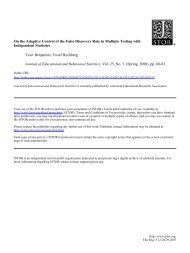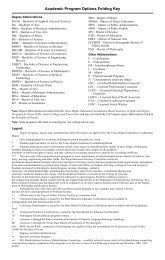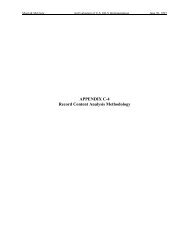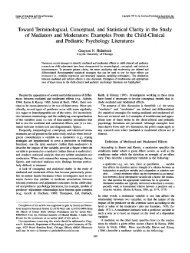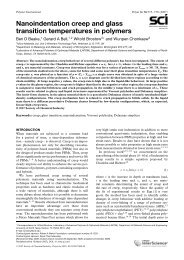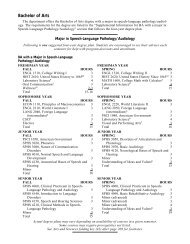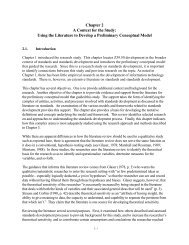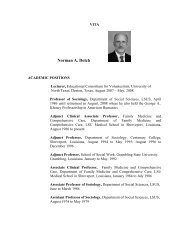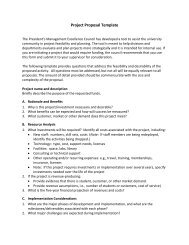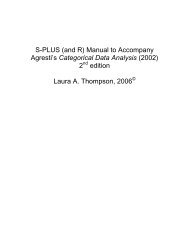Using the R Statistical Computing Environment to Teach Social ...
Using the R Statistical Computing Environment to Teach Social ...
Using the R Statistical Computing Environment to Teach Social ...
- No tags were found...
You also want an ePaper? Increase the reach of your titles
YUMPU automatically turns print PDFs into web optimized ePapers that Google loves.
USING THE R STATISTICAL COMPUTING ENVIRONMENT<br />
TO TEACH SOCIAL STATISTICS COURSES*<br />
John Fox and Robert Andersen<br />
Department of Sociology<br />
McMaster University<br />
January 2005<br />
* Acknowledgements: Support for developing <strong>the</strong> Rcmdr package discussed in this paper was provided by <strong>the</strong> Arts<br />
Research Board of McMaster University. We wish <strong>to</strong> thank Tony Christensen, a research assistant who<br />
systematically examined several introduc<strong>to</strong>ry-statistics texts <strong>to</strong> ensure that <strong>the</strong> Rcmdr package contains <strong>the</strong><br />
procedures commonly used in introduc<strong>to</strong>ry statistics courses, and helped <strong>to</strong> test <strong>the</strong> program.
USING THE R STATISTICAL COMPUTING ENVIRONMENT<br />
TO TEACH SOCIAL STATISTICS COURSES<br />
ABSTRACT<br />
R is a free, cooperatively developed, open-source implementation of <strong>the</strong> S statistical programming language and<br />
computing environment, a language that has become a de-fac<strong>to</strong> standard among statisticians for <strong>the</strong> development of<br />
statistical software. The goal of this paper is <strong>to</strong> show <strong>the</strong> value of using R <strong>to</strong> teach social statistics courses. The paper<br />
briefly introduces R, and describes its use in four such courses: two introduc<strong>to</strong>ry courses (one for undergraduates<br />
and <strong>the</strong> o<strong>the</strong>r for graduate students), in which students interact with R through a graphical-user interface; a graduate<br />
course on applied regression and generalized linear models; and a more advanced graduate course that takes up<br />
several <strong>to</strong>pics, including structural-equation models, survival analysis, and mixed-effects models for hierarchical and<br />
longitudinal data.<br />
keywords: social-statistics education, statistical computing, S language, open-source software<br />
1
USING THE R STATISTICAL COMPUTING ENVIRONMENT<br />
TO TEACH SOCIAL STATISTICS COURSES<br />
R (Ihaka and Gentleman 1996) is a free, cooperatively developed, open-source implementation of S, a<br />
powerful and flexible statistical programming language and computing environment that has become <strong>the</strong> effective<br />
standard among statisticians. Despite its strong points, and its large user base among statisticians, it is fair <strong>to</strong> say that<br />
R and its commercial cousin S-PLUS are not widely used by sociologists and o<strong>the</strong>r social scientists. Never<strong>the</strong>less,<br />
interest in R among social scientists is increasing. For example, since 2002 several relatively advanced courses at <strong>the</strong><br />
Summer Program of <strong>the</strong> Inter-University Consortium for Political and <strong>Social</strong> Research (ICPSR) have coordinated<br />
<strong>the</strong>ir use of R, and <strong>the</strong> Program has introduced a lecture series on S that focuses on R. Similarly, <strong>the</strong> Oxford Spring<br />
School in Quantitative Methods for <strong>Social</strong> Research also emphasizes <strong>the</strong> use of R, along with Stata, in its<br />
workshops. 1<br />
The principal goal of this paper is <strong>to</strong> demonstrate <strong>the</strong> advantages of using R in social statistics courses, both<br />
at <strong>the</strong> undergraduate and graduate level. The paper is divided in<strong>to</strong> three sections: (1) a general discussion of R, its<br />
benefits, and how it can be obtained; (2) a brief introduction <strong>to</strong> computing with R; and (3) a description of how R is<br />
currently being used in four social statistics courses in <strong>the</strong> Sociology Department at McMaster University in<br />
Hamil<strong>to</strong>n, Ontario, Canada.<br />
WHAT IS R AND WHY USE IT<br />
The S programming language was originally developed at Bell Labs by John Chambers and o<strong>the</strong>rs (Becker,<br />
Chambers and Wilks 1988; Chambers 1998; Chambers and Hastie 1992). A commercial implementation of S, called<br />
S-PLUS, is sold by Insightful Corporation (see http://www.insightful.com/products/splus/) and has been available,<br />
in one or ano<strong>the</strong>r form, for two decades. More recently, R, which has facilities generally comparable <strong>to</strong> those of S-<br />
PLUS, has become a popular implementation of S. The basic R system, and contributed packages, are available from<br />
<strong>the</strong> Comprehensive R Archive Network (CRAN) at http://cran.r-project.org/.<br />
Aside from its price (i.e., zero), <strong>the</strong>re are several o<strong>the</strong>r reasons <strong>to</strong> adopt R in preference <strong>to</strong> o<strong>the</strong>r commonly used<br />
statistics programs:<br />
2
• R is high quality software. Several of <strong>the</strong> leading figures in statistical computing (e.g., Douglas Bates, John<br />
Chambers, Brian Ripley, and Luke Tierney) are closely associated with <strong>the</strong> development of R.<br />
• The S statistical computing language is very well designed, both from <strong>the</strong> point of view of <strong>the</strong> practicing<br />
data analyst and from that of <strong>the</strong> computer scientist. Indeed, John Chambers received <strong>the</strong> 1998 Software<br />
System Award from <strong>the</strong> Association for <strong>Computing</strong> Machinery (ACM – <strong>the</strong> principal professional<br />
organization of computer scientists) for developing S. Chambers is now a member of <strong>the</strong> R core<br />
development team.<br />
• The basic R system is supplemented by several “recommended packages” which are part of <strong>the</strong> standard R<br />
distribution. In addition <strong>to</strong> <strong>the</strong> recommended packages, at <strong>the</strong> time of writing more than 400 “contributed<br />
packages” are freely available from CRAN, many representing <strong>the</strong> state of <strong>the</strong> art in various areas of<br />
statistical computing. The basic R system augmented by <strong>the</strong> contributed packages is arguably <strong>the</strong> most<br />
extensive resource for statistical computing currently available.<br />
• Reflecting its origin at Bell Labs, S (including R) incorporates excellent facilities for drawing statistical<br />
graphs, including “Trellis graphics” (Cleveland 1993).<br />
• Because it incorporates a true programming language, R is relatively easily extended. This is an attractive<br />
characteristic for instruc<strong>to</strong>rs, and for students in advanced classes.<br />
• R runs on all of <strong>the</strong> commonly used computer platforms – including Windows systems, Unix/Linux<br />
systems, and Macin<strong>to</strong>shes – and installs in <strong>the</strong> normal manner on each platform. (S-PLUS, in contrast, has<br />
no Macin<strong>to</strong>sh version.)<br />
Unlike statistical packages such as SPSS and Minitab, which provide point-and-click graphical-user interfaces<br />
(“GUIs”) <strong>to</strong> most of <strong>the</strong>ir statistical capabilities, R is command-oriented: Users normally type commands at a<br />
command-prompt (or in a programming edi<strong>to</strong>r, such as WinEdt or Emacs), and <strong>the</strong> R interpreter responds<br />
interactively <strong>to</strong> <strong>the</strong>se commands. R’s somewhat misleadingly named “Rgui” for Windows provides some basic<br />
functions, such as menus for downloading and loading packages (in <strong>the</strong> Packages menu), as alternatives <strong>to</strong><br />
commands, but it does not incorporate a GUI for statistical procedures; Rgui does, however, provide a basic<br />
programming edi<strong>to</strong>r in <strong>the</strong> form of “script” windows.<br />
3
A command-oriented interface <strong>to</strong> statistical software provides a number of important advantages, especially <strong>to</strong><br />
advanced or regular users:<br />
• It is easier in a command-driven system <strong>to</strong> correct, modify, and replicate analyses. It is true that many<br />
statistical programs (e.g., SPSS) have GUIs that are capable of generating commands, but in our experience<br />
users who rely on a GUI rarely take advantage of this feature, preferring instead <strong>to</strong> point and click <strong>the</strong>ir<br />
way through <strong>the</strong> GUI ra<strong>the</strong>r than editing commands.<br />
• It is simpler, and natural, <strong>to</strong> create a permanent record of one’s work, including both input and output.<br />
Indeed, R accommodates sophisticated facilities for “literate programming” (Knuth, 1992) in which<br />
commands and output can be mixed in a natural manner with explana<strong>to</strong>ry text (Leisch, 2002).<br />
• GUIs <strong>to</strong> complex statistical systems are ei<strong>the</strong>r incomplete (necessitating <strong>the</strong> use of commands for more<br />
advanced or non-standard analyses) or Byzantine (requiring <strong>the</strong> user <strong>to</strong> drill down through a complex maze<br />
of menus, dialog boxes, and graphical controls) – or both.<br />
Those who migrate <strong>to</strong> R from point-and-click statistical software may not be immediately comfortable with <strong>the</strong><br />
command-oriented S programming language, but in many respects R is initially much simpler for someone entirely<br />
new <strong>to</strong> statistical computing. More importantly, R implicitly encourages a deeper understanding of <strong>the</strong> statistical<br />
procedures being used than do some o<strong>the</strong>r programs, such as SPSS and Minitab. Notwithstanding <strong>the</strong>se points, R<br />
does include <strong>to</strong>ols <strong>to</strong> construct graphical interfaces, most prominently via <strong>the</strong> tcltk package (one of <strong>the</strong><br />
“recommended” R packages, which are a part of <strong>the</strong> standard R distribution; see Dalgaard 2001, 2002), which<br />
provides access <strong>to</strong> <strong>the</strong> Tcl/Tk GUI builder (Welch 2000). Tcl/Tk systems are freely available for all major<br />
computing platforms, and <strong>the</strong> standard distribution of R for Windows includes a basic Tcl/Tk system that is installed<br />
along with R. A GUI interface built using <strong>the</strong>se <strong>to</strong>ols is provided by <strong>the</strong> Rcmdr (“R Commander”) package, which<br />
is described later in this paper.<br />
A QUICK TOUR OF R<br />
Although it is not feasible <strong>to</strong> provide a general introduction <strong>to</strong> R within <strong>the</strong> confines of this paper, we<br />
never<strong>the</strong>less attempt <strong>to</strong> convey enough background information <strong>to</strong> render <strong>the</strong> remainder of <strong>the</strong> paper intelligible. S is<br />
4
a functional programming language: programs – both those supplied with R and those written by <strong>the</strong> user – take <strong>the</strong><br />
form of functions, and S expressions entail function calls. Even opera<strong>to</strong>rs, such as <strong>the</strong> + opera<strong>to</strong>r for addition and *<br />
opera<strong>to</strong>r for multiplication, implicitly invoke functions. When <strong>the</strong> R program is started, and after it prints an<br />
introduc<strong>to</strong>ry message, <strong>the</strong> R interpreter prompts for input with > (<strong>the</strong> greater-than sign). The interpreter executes<br />
expressions that are typed at <strong>the</strong> command prompt. For example:<br />
> 1 + 2*3<br />
[1] 7<br />
> 1:3<br />
[1] 1 2 3<br />
> 1:3 + c(2, 5, -1)<br />
[1] 3 7 2<br />
> x 5*x<br />
[1] 5 10 15<br />
Most of <strong>the</strong> preceding interaction with <strong>the</strong> R interpreter is likely self-explana<strong>to</strong>ry, with <strong>the</strong> following exceptions:<br />
• Simple (“vec<strong>to</strong>r”) output is prefixed by [1]. Were output <strong>to</strong> extend over several lines, <strong>the</strong> index number of<br />
<strong>the</strong> first element in each line would appear in square brackets at <strong>the</strong> beginning of <strong>the</strong> line.<br />
• c() is <strong>the</strong> “combine” function, which creates a vec<strong>to</strong>r from its arguments. In general, <strong>the</strong> arguments <strong>to</strong><br />
functions in <strong>the</strong> S language are specified within paren<strong>the</strong>ses and separated by commas; where arguments <strong>to</strong><br />
a function are named, <strong>the</strong>y are specified as name = value.<br />
•
for data input: Data can be read from text files, binary files, <strong>the</strong> clipboard, <strong>the</strong> Internet, and attached packages;<br />
imported from o<strong>the</strong>r statistical packages and spreadsheet programs; and input through connections <strong>to</strong> scientific<br />
devices. Moreover, a transparent link can be established between R and a database-management system, permitting<br />
<strong>the</strong> manipulation and analysis of very large data sets (R normally keeps active data in memory, a limitation that is<br />
not very restrictive in an era of multi-Gigabyte computers).<br />
One of <strong>the</strong> simplest ways <strong>to</strong> get data in<strong>to</strong> R is from a package that is attached via <strong>the</strong> library function;<br />
packages of data can be created for course use, for example. To illustrate, <strong>the</strong> car package (associated with Fox<br />
2002) includes a “data frame” (rectangular data set) named Prestige, which contains data on <strong>the</strong> prestige and<br />
some o<strong>the</strong>r characteristics of 102 Canadian occupations circa 1970. The variables in <strong>the</strong> data set, which are fur<strong>the</strong>r<br />
discussed in Fox (1997, 2002), are as follows: prestige is <strong>the</strong> average prestige rating of <strong>the</strong> occupation, on a 0 <strong>to</strong><br />
100 scale; income is <strong>the</strong> average income of occupational incumbents, in dollars; education is <strong>the</strong> average years<br />
of schooling of occupational incumbents; and type is a “fac<strong>to</strong>r” (categorical variable) with three “levels”<br />
(categories) – bc (blue collar), wc (white collar), and prof (professional and managerial). Three occupations have<br />
missing type. The commands below load <strong>the</strong> car package, read <strong>the</strong> data set in<strong>to</strong> memory, and display <strong>the</strong><br />
observations (<strong>the</strong> ellipses, . . ., represent elided lines, and NA is a missing-data indica<strong>to</strong>r):<br />
> library(car)<br />
> data(Prestige)<br />
> Prestige<br />
education income women prestige census type<br />
GOV.ADMINISTRATORS 13.11 12351 11.16 68.8 1113 prof<br />
GENERAL.MANAGERS 12.26 25879 4.02 69.1 1130 prof<br />
ACCOUNTANTS 12.77 9271 15.70 63.4 1171 prof<br />
. . .<br />
NURSING.AIDES 9.45 3485 76.14 34.9 3135 bc<br />
PHYSIO.THERAPSTS 13.62 5092 82.66 72.1 3137 prof<br />
PHARMACISTS 15.21 10432 24.71 69.3 3151 prof<br />
MEDICAL.TECHNICIANS 12.79 5180 76.04 67.5 3156 wc<br />
COMMERCIAL.ARTISTS 11.09 6197 21.03 57.2 3314 prof<br />
RADIO.TV.ANNOUNCERS 12.71 7562 11.15 57.6 3337 wc<br />
ATHLETES 11.44 8206 8.13 54.1 3373 <br />
. . .<br />
BOOKBINDERS 8.55 3617 70.87 35.2 9517 bc<br />
> dim(Prestige)<br />
[1] 102 6<br />
6
The R “search path” determines where <strong>the</strong> interpreter will look for objects; <strong>the</strong> path initially includes <strong>the</strong><br />
“global environment” – which contains objects created during <strong>the</strong> R session – and several packages that are attached<br />
by default. As with most aspects of R, <strong>the</strong> list of initially attached packages is configurable, and can easily be<br />
adapted <strong>to</strong> <strong>the</strong> needs of a specific course. A convenient way <strong>to</strong> compute with <strong>the</strong> variables in a data set is <strong>to</strong> attach<br />
<strong>the</strong> data frame <strong>to</strong> <strong>the</strong> search path. Variables in <strong>the</strong> data frame will <strong>the</strong>n be accessible much as if <strong>the</strong>y had been<br />
entered at <strong>the</strong> keyboard:<br />
> attach(Prestige)<br />
> mean(income)<br />
[1] 6797.902<br />
> median(income)<br />
[1] 5930.5<br />
> summary(type)<br />
bc prof wc NA's<br />
44 31 23 4<br />
> summary(education)<br />
Min. 1st Qu. Median Mean 3rd Qu. Max.<br />
6.380 8.445 10.540 10.740 12.650 15.970<br />
summary is an example of a “generic function,” a functions that adapts its behavior <strong>to</strong> its input. Thus, summary<br />
produces counts for <strong>the</strong> fac<strong>to</strong>r type, but a five-number summary plus <strong>the</strong> mean for <strong>the</strong> numeric variable<br />
education.<br />
It is also very easy <strong>to</strong> read data from a text file. Suppose, for example, that <strong>the</strong> Canadian occupationalprestige<br />
data reside in <strong>the</strong> file c:\data\prestige.txt with <strong>the</strong> following contents:<br />
education income women prestige census type<br />
GOV.ADMINISTRATORS<br />
13.11 12351 11.16 68.8 1113 prof<br />
GENERAL.MANAGERS<br />
12.26 25879 4.02 69.1 1130 prof<br />
ACCOUNTANTS<br />
12.77 9271 15.70 63.4 1171 prof<br />
. . .<br />
To read <strong>the</strong> data in<strong>to</strong> a data frame named Canadian.Prestige:<br />
> Canadian.Prestige
different input-data formats. Note that forward slashes (/) are used <strong>to</strong> separate direc<strong>to</strong>ries, even in Windows<br />
systems.<br />
<strong>Statistical</strong> Models<br />
The statistical modeling facilities in S are one of <strong>the</strong> great strengths of <strong>the</strong> language: S provides a version of<br />
<strong>the</strong> Wilkinson and Rogers (1973) notation for describing linear and related models (ano<strong>the</strong>r version of which is used<br />
in SAS), and S functions for statistical modeling return objects that can <strong>the</strong>n be subjected <strong>to</strong> fur<strong>the</strong>r computations –<br />
<strong>to</strong> extract residuals, plot various quantities, print an analysis-of-variance table, print a model summary, and so on.<br />
This approach contrasts with that in a statistical package, such as SPSS or SAS, which is primarily oriented <strong>to</strong>wards<br />
turning data sets in<strong>to</strong> printed and plotted output. Moreover, <strong>the</strong> handling of fac<strong>to</strong>rs and interactions is especially<br />
convenient in S. Unlike many commonly used programs such as SPSS and Stata, when <strong>the</strong> data are input, R by<br />
default treats character data as fac<strong>to</strong>rs, thus avoiding <strong>the</strong> hassle of having <strong>to</strong> specify labels—i.e., category names can<br />
be used directly ra<strong>the</strong>r than assigning numbers which <strong>the</strong>n need <strong>to</strong> be given value labels. There is also no need <strong>to</strong><br />
construct product variables for interaction terms directly because <strong>the</strong>y are specified simply and more naturally as<br />
part of a model formula. A brief and partial description of model formulas is shown in Table 1.<br />
[Table 1 about here]<br />
To illustrate, <strong>the</strong> following command invokes <strong>the</strong> lm function <strong>to</strong> create a linear-model object, regressing<br />
<strong>the</strong> variable prestige on income, education, and type of occupation, and permitting income and<br />
education <strong>to</strong> interact with type:<br />
> mod
summary(mod)<br />
Call:<br />
lm(formula = prestige ~ (income + education) * type)<br />
Residuals:<br />
Min 1Q Median 3Q Max<br />
-13.462 -4.225 1.346 3.826 19.631<br />
Coefficients:<br />
Estimate Std. Error t value Pr(>|t|)<br />
(Intercept) 2.2757530 7.0565809 0.323 0.7478<br />
income 0.0035224 0.0005563 6.332 9.62e-09 ***<br />
education 1.7132747 0.9572405 1.790 0.0769 .<br />
typeprof 15.3518963 13.7152577 1.119 0.2660<br />
typewc -33.5366519 17.6536726 -1.900 0.0607 .<br />
income:typeprof -0.0029026 0.0005989 -4.847 5.28e-06 ***<br />
income:typewc -0.0020719 0.0008940 -2.318 0.0228 *<br />
education:typeprof 1.3878090 1.2886282 1.077 0.2844<br />
education:typewc 4.2908748 1.7572512 2.442 0.0166 *<br />
---<br />
Signif. codes: 0 `***' 0.001 `**' 0.01 `*' 0.05 `.' 0.1 ` ' 1<br />
Residual standard error: 6.318 on 89 degrees of freedom<br />
Multiple R-Squared: 0.8747, Adjusted R-squared: 0.8634<br />
F-statistic: 77.64 on 8 and 89 DF, p-value: < 2.2e-16<br />
Because type is a fac<strong>to</strong>r, it au<strong>to</strong>matically gives rise <strong>to</strong> a set of dummy-coded (0/1) contrasts. O<strong>the</strong>r contrast-coding<br />
schemes, including cus<strong>to</strong>mized contrasts, may be employed as well. To obtain an analysis of variance table for <strong>the</strong><br />
regression,<br />
> Anova(mod)<br />
Anova Table (Type II tests)<br />
Response: prestige<br />
Sum Sq Df F value Pr(>F)<br />
income 1131.9 1 28.3544 7.511e-07 ***<br />
education 1068.0 1 26.7532 1.413e-06 ***<br />
type 591.2 2 7.4044 0.001060 **<br />
income:type 951.8 2 11.9210 2.588e-05 ***<br />
education:type 238.4 2 2.9859 0.055574 .<br />
Residuals 3552.9 89<br />
---<br />
Signif. codes: 0 `***' 0.001 `**' 0.01 `*' 0.05 `.' 0.1 ` ' 1<br />
<strong>Statistical</strong> Graphics<br />
9
There are exceptional facilities for statistical graphics in R, both in <strong>the</strong> basic R system and in add-on<br />
packages. The generic plot function, for example, is extremely flexible and powerful. Graphs of varying<br />
complexity can be built in a sequence of typically simple commands that give <strong>the</strong> user complete control over <strong>the</strong><br />
appearance of <strong>the</strong> graph. For example, in sequential order, <strong>the</strong> commands below draw a scatterplot, add a leastsquares<br />
line, and place a title above <strong>the</strong> graph (producing Figure 1). The last line allows us <strong>to</strong> identify points on <strong>the</strong><br />
graph interactively using <strong>the</strong> mouse.<br />
> plot(income, prestige)<br />
> abline(lm(prestige ~ income))<br />
> title("Scatterplot of Prestige vs. Income")<br />
> identify(income, prestige, row.names(Prestige))<br />
Even this simple graph is of near publication quality, but cus<strong>to</strong>mization is also straightforward. Point<br />
symbols, sizes and colors, line types, axes labels, and many o<strong>the</strong>r graphical elements can be changed with simple<br />
commands. Even type-set-quality ma<strong>the</strong>matical annotation within in a graph is easily produced (Murrell and Ihaka,<br />
2000). Moreover, more advanced two-dimensional plots, such as Trellis graphics (see Cleveland 1993), can be<br />
constructed using <strong>the</strong> lattice package, which is part of <strong>the</strong> standard R distribution. Sophisticated dynamic 3D<br />
graphs can be constructed using <strong>the</strong> rgl package.<br />
[Figure 1 about here]<br />
Yet ano<strong>the</strong>r feature of R that sets it apart from programs commonly used by sociologists is its facilities for<br />
model diagnostics. Simple functions extract or compute various quantities from model objects that can <strong>the</strong>n be used<br />
<strong>to</strong> perform diagnostics and construct graphs — e.g., residuals(mod) returns residuals, while fitted(mod)<br />
returns <strong>the</strong> fitted values. Simple diagnostic plots can also be directly constructed using <strong>the</strong> generic plot function on<br />
a model object. Following from <strong>the</strong> example above, <strong>the</strong> command plot(mod) produces a four-panel graph of<br />
diagnostic plots (shown in Figure 2): (1) a plot of residuals versus fitted values; (2) a normal quantile-comparison<br />
plot of <strong>the</strong> residuals; (3) a scale-location plot of <strong>the</strong> square root of <strong>the</strong> absolute residuals against fitted values; and (4)<br />
a plot of Cook’s distances versus observation indices.<br />
A more comprehensive set of functions for diagnostic plots—including added-variable plots, componentplus-residual<br />
plots, leverage plots, and spread-level plots—is available in <strong>the</strong> car package. The car package also<br />
10
includes functions for testing for au<strong>to</strong>correlated errors, for non-constant error variance, and for outliers, and<br />
functions for Box-Cox and Box-Tidwell transformations, respectively, of <strong>the</strong> response and explana<strong>to</strong>ry variables in a<br />
regression. O<strong>the</strong>r common diagnostics are available in <strong>the</strong> lmtest package.<br />
[Figure 2 about here]<br />
Contributed Packages<br />
As mentioned earlier, <strong>the</strong> flexibility of R has led <strong>to</strong> <strong>the</strong> development of a wide range of add-on packages. In<br />
combination, <strong>the</strong>se packages extend R <strong>to</strong> include functions for all statistical models commonly used by social<br />
scientists. Here is a partial list of <strong>the</strong>se methods (with associated packages in paren<strong>the</strong>ses): generalized linear models<br />
(base), multinomial logit models (nnet), social network analysis (sna), structural equation modeling with latent<br />
variables (sem), latent class analysis (e1071), smoothing splines and generalized additive models (mgcv), mixedeffects<br />
models (nlme), event-his<strong>to</strong>ry analysis (survival), bootstrapping (boot), cluster analysis (mclust).<br />
(This association of methods with packages understates <strong>the</strong> richness of R: In most of <strong>the</strong>se instances, relevant<br />
software is provided in o<strong>the</strong>r packages as well. For example, <strong>the</strong> gam package also provides facilities for<br />
generalized additive models.) Some of <strong>the</strong>se packages will be described in more detail when we discuss <strong>the</strong> use of R<br />
in graduate statistics courses later in <strong>the</strong> paper.<br />
If <strong>the</strong> user’s computer is connected <strong>to</strong> <strong>the</strong> Internet, contributed packages can be installed or updated directly<br />
from CRAN within R itself, ei<strong>the</strong>r by using <strong>the</strong> Packages menu in <strong>the</strong> R Console or from <strong>the</strong> command prompt; for<br />
example, <strong>to</strong> download and install <strong>the</strong> car package:<br />
> install.packages("car")<br />
Packages can also be installed from zip files located on a local disk.<br />
Getting Help<br />
Despite being free, R is extensively documented. For example, <strong>the</strong> standard R distribution comes with a<br />
complete set of manuals, including a decent introduc<strong>to</strong>ry manual. Moreover, contributed R packages incorporate a<br />
standard method of providing documentation that generates help files appropriate <strong>to</strong> <strong>the</strong> user’s computing platform.<br />
(In fact, contributed packages are not posted on CRAN unless <strong>the</strong>y have <strong>the</strong> required documentation.) Standard<br />
11
Windows help is available via a Help menu, but help is can also be obtained in a number of ways from <strong>the</strong> command<br />
prompt:<br />
• help(lm) or lm: Opens <strong>the</strong> help file for an object – in this case, for <strong>the</strong> lm function.<br />
• help.search("logistic"): Searches all installed help files for a particular sequence of characters<br />
– here, for <strong>the</strong> word “logistic.”<br />
• apropos("norm"): Searches for a character sequence (“norm”) in <strong>the</strong> names of all objects available in<br />
<strong>the</strong> current R session.<br />
Help files for individual packages can also be printed as manuals.<br />
In addition <strong>to</strong> <strong>the</strong> free documentation included with R itself, S and R are <strong>the</strong> subject of several texts (see, in<br />
particular, Fox 2002; Venables and Ripley 2000, 2002), and a number of o<strong>the</strong>r books are associated with software<br />
that is available in R packages (e.g., Davison and Hinkley 1997; Efron and Tibshirani 1993; Pinheiro and Bates<br />
2000; Therneau and Grambsch 2000). Finally, R users have access <strong>to</strong> excellent support in <strong>the</strong> r-help email list (see,<br />
http://www.r-project.org/mail). Before posting a question <strong>to</strong> <strong>the</strong> r-help list, however, please read <strong>the</strong> posting guide at<br />
http://www.r-project.org/posting-guide.html.<br />
SOCIAL STATISTICS COURSES AT MCMASTER UNIVERSITY<br />
The remainder of this paper describes <strong>the</strong> use of R in four social-statistics courses taught at McMaster<br />
University in Hamil<strong>to</strong>n, Ontario, Canada:<br />
• Two of <strong>the</strong>se courses (Sociology 3H06 and 6Z03) are introduc<strong>to</strong>ry social-statistics courses, for<br />
undergraduates and graduate students, respectively. The courses have nearly <strong>the</strong> same content. The<br />
undergraduate course is required of all Sociology honours majors (which, in Canada, is <strong>the</strong> four-year<br />
bachelor’s degree programme). The graduate course is essentially remedial.<br />
• The third course (Sociology 740) covers linear and generalized linear models, and is required of all of our<br />
PhD students.<br />
• The fourth course (Sociology 761) is a more advanced social-statistics course, and is optional.<br />
12
Introduc<strong>to</strong>ry <strong>Social</strong> Statistics Courses<br />
Sociology 3H06 is a two-semester undergraduate introduc<strong>to</strong>ry social-statistics. Sociology 6Z03 is a onesemester<br />
version of <strong>the</strong> same course for graduate students who have a weak background in statistics. The current text<br />
for <strong>the</strong>se courses is Moore’s The Basic Practice of Statistics, Third Edition (Moore 2003). The course covers all of<br />
Moore’s text. In addition, we supplement Moore’s treatment of regression (with lecture material on multiple<br />
regression) and contingency tables. Detailed course outlines are available at<br />
http://socserv.socsci.mcmaster.ca/jfox/Courses/soc3h6/index.html,<br />
http://socserv.socsci.mcmaster.ca/andersen/soc3H6/index.htm, and<br />
http://socserv.socsci.mcmaster.ca/andersen/soc6Z3/index.htm.<br />
Students in <strong>the</strong>se classes are provided with a Windows CD/ROM with <strong>the</strong> software and data sets for <strong>the</strong><br />
class. The software can be run directly from <strong>the</strong> CD or installed on <strong>the</strong> student’s computer. R software and course<br />
data sets can also be accessed in university computer labs.<br />
Despite <strong>the</strong> benefits of R’s command language for <strong>the</strong> advanced user, a command-driven system has some<br />
disadvantages in an introduc<strong>to</strong>ry statistics course:<br />
• The learning curve is relatively “steep.” In contrast, a well-designed GUI is essentially self-teaching.<br />
• New and casual users frequently must look up commands. In contrast, a GUI presents users with options<br />
and consequently does not tax memory.<br />
• It is easy <strong>to</strong> make mistakes – such as typing errors, syntax errors, and <strong>the</strong> specification of nonsensical<br />
analyses – in a command-driven system. In contrast, a GUI eliminates most syntax and typing errors, and<br />
should, at least <strong>to</strong> an extent, protect users from nonsense.<br />
The Rcmdr (“R Commander”) package (described in more detail in Fox, 2004) provides a basic-statistics GUI<br />
for R, including methods of analysis typically covered in an introduc<strong>to</strong>ry statistics class <strong>to</strong>ge<strong>the</strong>r with linear and<br />
generalized linear models. The Rcmdr loads in <strong>the</strong> same manner as any R package, and is useable on all of <strong>the</strong><br />
platforms on which R runs. Moreover, commands can still be entered directly at <strong>the</strong> command prompt or via <strong>the</strong><br />
13
log/script window in <strong>the</strong> R Commander. The R Commander consequently makes it easy <strong>to</strong> carry out statistical<br />
analyses while at <strong>the</strong> same time facilitating <strong>the</strong> learning of R functions.<br />
Figure 3 shows part of a Windows XP desk<strong>to</strong>p with <strong>the</strong> R Commander window. Commands are generated via<br />
menus and dialog boxes accessed from <strong>the</strong> R Commander window. These commands are logged <strong>to</strong> <strong>the</strong> script<br />
window in <strong>the</strong> R Commander. Commands are also echoed <strong>to</strong> <strong>the</strong> R Commander output window along with printed<br />
output that is generated. Graphs appear in a separate graphics-device window, as illustrated in Figure 3. The script<br />
window incorporates a simple text edi<strong>to</strong>r, which allows <strong>the</strong> user <strong>to</strong> re-execute (e.g., via <strong>the</strong> Submit but<strong>to</strong>n), modify,<br />
enter, and save commands. O<strong>the</strong>r elements of <strong>the</strong> interface include but<strong>to</strong>ns <strong>to</strong> view and edit <strong>the</strong> “active” data set in a<br />
spreadsheet-like data edi<strong>to</strong>r; <strong>to</strong> change <strong>the</strong> active data set; and <strong>to</strong> change <strong>the</strong> active statistical model. Figure 4 shows<br />
a typical R Commander dialog box, <strong>to</strong> create <strong>the</strong> parallel boxplots shown in Figure 3.<br />
[Figures 3 and 4 about here]<br />
The R Commander was designed <strong>to</strong> cover <strong>the</strong> contents of Moore’s text, and of several o<strong>the</strong>r introduc<strong>to</strong>ry<br />
statistics texts that were consulted. The complete menu tree for <strong>the</strong> R Commander is shown in Figure 5. Use of R<br />
through <strong>the</strong> R Commander is not essentially different from <strong>the</strong> use of any menu-driven statistical package. Students<br />
in <strong>the</strong> graduate version of <strong>the</strong> course (Sociology 6Z3) are also encouraged <strong>to</strong> learn some R commands, a task that is<br />
facilitated by <strong>the</strong> commands that appear in <strong>the</strong> R Commander log window.<br />
[Figure 5 about here]<br />
To illustrate how <strong>the</strong> R Commander provides a graphical interface <strong>to</strong> R functions for linear and generalized<br />
linear models, we recall our example of prestige regressed on income, education, and type of occupation,<br />
including interactions of income and education with type. The same model can be specified using <strong>the</strong> R<br />
Commander GUI in <strong>the</strong> linear-model dialog box shown in Figure 6. In this case, <strong>the</strong> summary of <strong>the</strong> model will be<br />
printed after <strong>the</strong> model is fit, and <strong>the</strong> resulting linear-model object becomes <strong>the</strong> “active model.” Items in <strong>the</strong> Model<br />
menu (see Figure 5) apply <strong>to</strong> <strong>the</strong> active model. For example, <strong>the</strong> basic diagnostic plots produced by plotting a linear-<br />
14
model object, as shown previously in Figure 2, can also be constructed via <strong>the</strong> R Commander menus: Models <br />
Graphs Basic diagnostic plots (where <strong>the</strong> arrows denote menu selection).<br />
[Figure 6 about here]<br />
An Applied Regression Course<br />
Sociology 740 is a one-semester course in applied regression analysis required of all of our doc<strong>to</strong>ral<br />
students who have not already taken an equivalent course. The course is oriented <strong>to</strong>wards <strong>the</strong> use of statistical<br />
models for data analysis, and takes up explora<strong>to</strong>ry data analysis and variable transformations, linear statistical<br />
models, and generalized linear models (e.g., for categorical responses). There are two texts for <strong>the</strong> class: Applied<br />
Regression (Fox 1997) and a book on R and S-PLUS (Fox 2002). A detailed course outline is available at<br />
http://socserv.socsci.mcmaster.ca/jfox/Courses/soc740/index.html.<br />
The Rcmdr package covers almost all of <strong>the</strong> computing for <strong>the</strong> course, including several <strong>to</strong>pics on linearmodel<br />
and generalized-linear-model diagnostics. Students in <strong>the</strong> class – particularly those who intend <strong>to</strong> use<br />
quantitative methods in <strong>the</strong>ir work – are strongly encouraged, however, <strong>to</strong> learn <strong>to</strong> write R commands and <strong>to</strong><br />
understand <strong>the</strong> rudiments of programming in R. As in Sociology 3H06 and 6Z03 (and in Sociology 761, described<br />
below), students in Sociology 740 are provided with a Windows CD/ROM with <strong>the</strong> software and data for <strong>the</strong> class.<br />
A More Advanced Course in <strong>Social</strong> Statistics<br />
Sociology 761 is a one-semester course in social statistics, covering several selected <strong>to</strong>pics. Students in <strong>the</strong><br />
class also write a paper on a statistical <strong>to</strong>pic of <strong>the</strong>ir choice. In <strong>the</strong> Fall semester of 2004, <strong>the</strong> class began with<br />
introductions/refreshers on R, basic matrix algebra, and basic calculus, and proceeded <strong>to</strong> take up structural-equation<br />
models (including models with latent variables), survival (“event-his<strong>to</strong>ry”) analysis, and linear mixed models for<br />
hierarchical and longitudinal data. In <strong>the</strong> last two years, students in <strong>the</strong> class wrote papers on imputation of missing<br />
data, nonlinear regression, nonparametric regression, explora<strong>to</strong>ry fac<strong>to</strong>r analysis, interactions in latent-variable<br />
structural-equation models, and time-series regression. Again, a detailed course outline is available at<br />
http://socserv.socsci.mcmaster.ca/jfox/Courses/soc761/index.html.<br />
15
With <strong>the</strong> exception of structural-equation modeling, R has state-of-<strong>the</strong>-art capabilities in all of <strong>the</strong>se areas:<br />
• R includes excellent facilities for numerical linear algebra. In this class, students just scratch <strong>the</strong> surface,<br />
using R for basic matrix computations – products, inverses, determinants, etc.<br />
• One of us (Fox) is <strong>the</strong> author of <strong>the</strong> sem (structural-equation modeling) package in R, which is described in<br />
an on-line appendix <strong>to</strong> Fox (2002a), available at<br />
http://socserv.socsci.mcmaster.ca/jfox/Books/Companion/appendix.html. (Several o<strong>the</strong>r appendices, on<br />
<strong>to</strong>pics such as nonlinear regression, nonparametric regression, bootstrapping, etc., are also available at this<br />
location.) The sem package is capable of fitting observed-variable structural-equation models (SEMs) by<br />
two-stage least squares, and both observed-variable and latent-variable models by full-information<br />
maximum likelihood, assuming multinormality. Although adequate for a basic introduction <strong>to</strong> modern<br />
structural-equation modeling, <strong>the</strong> package is substantially more limited than special-purpose SEM software,<br />
such as LISREL, EQS, or Amos.<br />
• The survival package, originally written by Terry Therneau for S-PLUS and ported <strong>to</strong> R (see Therneau<br />
and Grambsch 2000), is arguably <strong>the</strong> most capable facility for survival analysis in any statistical software.<br />
• The nlme (nonlinear mixed-effects) package, by Pinheiro and Bates (2000), is also cutting-edge software<br />
that fits linear and nonlinear mixed-effects models. Software for generalized linear mixed models is also<br />
available in R – e.g., using <strong>the</strong> glmmPQL function in <strong>the</strong> MASS package (which is associated with<br />
Venables and Ripley, 2002), or <strong>the</strong> GLMM function in Bates’s lme4 package.<br />
• There are equally impressive facilities in R for missing-data imputation (e.g., <strong>the</strong> software associated with<br />
Shafer, 1997), for nonlinear regression (Bates’s nlm package), for nonparametric regression (e.g., <strong>the</strong><br />
mgcv and gam packages for fitting generalized additive models, Wood, 2000, 2003; Hastie and Tibshirani,<br />
1990), and for time-series regression (<strong>the</strong> gls function in <strong>the</strong> nlme package).<br />
Students in Sociology 761 learn <strong>to</strong> interact with R through <strong>the</strong> command-line interface, and acquire basic<br />
programming skills – for example <strong>to</strong> manage data. We take advantage of <strong>the</strong> extensibility of R by providing students<br />
16
with simple programs (available from <strong>the</strong> web site for <strong>the</strong> course) for computing life tables and for preparing<br />
survival data for analysis.<br />
An illustration: Cox regression for survival data. To convey a sense of what it is like <strong>to</strong> use R for more<br />
advanced statistical modeling, we provide an example of survival analysis from Sociology 761. The file<br />
Rossi.txt contains data from an experimental study of recidivism of 432 male prisoners, who were observed for<br />
a year after being released from prison (Rossi, Berk, and Lenihan 1980). The following variables are included in <strong>the</strong><br />
data; <strong>the</strong> variable names are those used by Allison (1995), from whom this example and variable descriptions are<br />
adapted:<br />
• week: week of first arrest after release, or censoring time.<br />
• arrest: <strong>the</strong> event indica<strong>to</strong>r, equal <strong>to</strong> 1 for those arrested during <strong>the</strong> period of <strong>the</strong> study and 0 for those who<br />
were not arrested.<br />
• fin: a dummy variable, equal <strong>to</strong> 1 if <strong>the</strong> individual received financial aid after release from prison, and 0 if he<br />
did not; financial aid was a randomly assigned fac<strong>to</strong>r manipulated by <strong>the</strong> researchers.<br />
• age: in years at <strong>the</strong> time of release.<br />
• race: a dummy variable coded 1 for blacks and 0 for o<strong>the</strong>rs.<br />
• wexp: a dummy variable coded 1 if <strong>the</strong> individual had full-time work experience prior <strong>to</strong> incarceration and 0 if<br />
he did not.<br />
• mar: a dummy variable coded 1 if <strong>the</strong> individual was married at <strong>the</strong> time of release and 0 if he was not.<br />
• paro: a dummy variable coded 1 if <strong>the</strong> individual was released on parole and 0 if he was not.<br />
• prio: number of prior convictions.<br />
• educ: education, a categorical variable, with codes 2 (grade 6 or less), 3 (grades 6 through 9), 4 (grades 10 and<br />
11), 5 (grade 12), or 6 (some post-secondary).<br />
• emp1 – emp52: dummy variables coded 1 if <strong>the</strong> individual was employed in <strong>the</strong> corresponding week of <strong>the</strong><br />
study and 0 o<strong>the</strong>rwise. Employment is <strong>the</strong>refore a time-varying covariate, and is ignored in <strong>the</strong> example<br />
developed below; in <strong>the</strong> course, <strong>the</strong> example is subsequently extended <strong>to</strong> consider <strong>the</strong> impact of employment.<br />
17
We read <strong>the</strong> data file in<strong>to</strong> a data frame directly from <strong>the</strong> course web site, and print <strong>the</strong> first few observations<br />
(omitting <strong>the</strong> variables emp1 – emp52, which are in columns 11–62 of <strong>the</strong> data frame):<br />
> Rossi Rossi[1:5, 1:10] # print <strong>the</strong> first 5 observations<br />
week arrest fin age race wexp mar paro prio educ<br />
1 20 1 0 27 1 0 0 1 3 3<br />
2 17 1 0 18 1 0 0 1 8 4<br />
3 25 1 0 19 0 1 0 1 13 3<br />
4 52 0 1 23 1 1 1 1 1 5<br />
5 52 0 0 19 0 1 0 1 3 3<br />
Thus, for example, <strong>the</strong> first individual was arrested in week 20 of <strong>the</strong> study, while <strong>the</strong> fourth individual was never<br />
rearrested, and hence has a censoring time of 52. (The argument header=TRUE is necessary here because although<br />
variable names are included in <strong>the</strong> first row of <strong>the</strong> data file, <strong>the</strong>re are no row names. Since <strong>the</strong> first and subsequent<br />
lines <strong>the</strong>refore have <strong>the</strong> same number of fields, read.table cannot deduce that <strong>the</strong> first line contains variable<br />
names.).<br />
follows:<br />
Following Allison, a Cox regression of time <strong>to</strong> rearrest on <strong>the</strong> time-constant covariates is specified as<br />
> mod.allison summary(mod.allison)<br />
Call:<br />
coxph(formula = Surv(week, arrest) fin + age + race + wexp +<br />
mar + paro + prio, data = Rossi)<br />
n= 432<br />
coef exp(coef) se(coef) z p<br />
fin -0.3794 0.684 0.1914 -1.983 0.0470<br />
age -0.0574 0.944 0.0220 -2.611 0.0090<br />
race 0.3139 1.369 0.3080 1.019 0.3100<br />
wexp -0.1498 0.861 0.2122 -0.706 0.4800<br />
mar -0.4337 0.648 0.3819 -1.136 0.2600<br />
paro -0.0849 0.919 0.1958 -0.434 0.6600<br />
prio 0.0915 1.096 0.0286 3.195 0.0014<br />
exp(coef) exp(-coef) lower .95 upper .95<br />
fin 0.684 1.461 0.470 0.996<br />
age 0.944 1.059 0.904 0.986<br />
race 1.369 0.731 0.748 2.503<br />
wexp 0.861 1.162 0.568 1.305<br />
18
mar 0.648 1.543 0.307 1.370<br />
paro 0.919 1.089 0.626 1.348<br />
prio 1.096 0.913 1.036 1.159<br />
Rsquare= 0.074 (max possible= 0.956 )<br />
Likelihood ratio test= 33.3 on 7 df, p=2.36e-05<br />
Wald test = 32.1 on 7 df, p=3.86e-05<br />
Score (logrank) test = 33.5 on 7 df, p=2.11e-05<br />
• Notice here that as an alternative <strong>to</strong> attaching <strong>the</strong> Rossi data frame <strong>to</strong> <strong>the</strong> search path, we have specified a<br />
data argument <strong>to</strong> <strong>the</strong> coxph function.<br />
• The column marked z in <strong>the</strong> output records <strong>the</strong> ratio of each regression coefficient <strong>to</strong> its standard error, a Wald<br />
statistic which is asymp<strong>to</strong>tically standard normal under <strong>the</strong> hypo<strong>the</strong>sis that <strong>the</strong> corresponding β is zero. The<br />
covariates age and prio (prior convictions) have highly statistically significant coefficients, while <strong>the</strong><br />
coefficient for fin (financial aid – <strong>the</strong> focus of <strong>the</strong> study) is marginally significant.<br />
• The exponentiated coefficients in <strong>the</strong> second column of <strong>the</strong> first panel (and in <strong>the</strong> first column of <strong>the</strong> second<br />
panel) of <strong>the</strong> output are interpretable as multiplicative effects on <strong>the</strong> hazard. Thus, for example, holding <strong>the</strong><br />
o<strong>the</strong>r covariates constant, an additional year of age on average reduces <strong>the</strong> weekly hazard of rearrest by a fac<strong>to</strong>r<br />
of<br />
e b age<br />
= 0.944 – that is, by 5.6 percent. Similarly, each prior conviction increases <strong>the</strong> hazard by a fac<strong>to</strong>r of<br />
1.096, or 9.6 percent.<br />
• The likelihood-ratio, Wald, and score chi-square statistics at <strong>the</strong> bot<strong>to</strong>m of <strong>the</strong> output are asymp<strong>to</strong>tically<br />
equivalent tests of <strong>the</strong> omnibus null hypo<strong>the</strong>sis that all of <strong>the</strong> β’s are zero. In this instance, <strong>the</strong> test statistics are<br />
in close agreement, and <strong>the</strong> hypo<strong>the</strong>sis is soundly rejected.<br />
Having fit a Cox model <strong>to</strong> <strong>the</strong> data, we now examine <strong>the</strong> estimated distribution of survival times. The R<br />
function survfit estimates <strong>the</strong> survival function S(t), by default at <strong>the</strong> mean values of <strong>the</strong> covariates. The plot<br />
method for objects returned by survfit graphs <strong>the</strong> estimated surivival function, along with a point-wise 95-<br />
percent confidence band. For example, for <strong>the</strong> model just fit <strong>to</strong> <strong>the</strong> recidivism data:<br />
> plot(survfit(mod.allison), ylim=c(.7, 1), xlab='Weeks',<br />
+ ylab='Proportion Not Rearrested')<br />
This command produces Figure 7. [The limits for <strong>the</strong> vertical axis, set by ylim=c(.7, 1), were selected after<br />
examining an initial plot.]<br />
19
[Figure 7 about here]<br />
Even more cogently, we may wish <strong>to</strong> display how estimated survival depends upon <strong>the</strong> value of a covariate.<br />
Because <strong>the</strong> principal purpose of <strong>the</strong> recidivism study was <strong>to</strong> assess <strong>the</strong> impact of financial aid on rearrest, we focus<br />
on this covariate. We construct a new data frame with two rows, one for each value of fin; <strong>the</strong> o<strong>the</strong>r covariates are<br />
fixed <strong>to</strong> <strong>the</strong>ir average values. (In <strong>the</strong> case of a dummy covariate, such as race, <strong>the</strong> average value is <strong>the</strong> proportion<br />
coded 1 in <strong>the</strong> data set – for race, <strong>the</strong> proportion of blacks). This data frame is passed <strong>to</strong> survfit via <strong>the</strong><br />
newdata argument:<br />
> attach(Rossi)<br />
> Rossi.fin detach()<br />
> plot(survfit(mod.allison, newdata=Rossi.fin),<br />
+ conf.int=TRUE, lty=c(1,2), ylim=c(.6, 1))<br />
> legend(loca<strong>to</strong>r(1), legend=c('fin = 0', 'fin = 1'),<br />
+ lty=c(1,2))<br />
We specified two additional arguments <strong>to</strong> plot: lty=c(1,2) indicates that <strong>the</strong> survival function for <strong>the</strong> first<br />
group (i.e., for fin = 0) will be plotted with a solid line, while that for <strong>the</strong> second group (fin = 1) will be plotted<br />
with a broken line (line types can be specified by number – as here – or by name); conf.int=TRUE requests that<br />
confidence envelopes be drawn around each estimated survival function (which is not <strong>the</strong> default when more than<br />
one survival function is plotted). Notice, as well, <strong>the</strong> use of <strong>the</strong> legend function (along with loca<strong>to</strong>r) <strong>to</strong> place a<br />
legend on <strong>the</strong> plot: We clicked <strong>the</strong> left mouse but<strong>to</strong>n <strong>to</strong> position <strong>the</strong> legend. The resulting graph, which appears in<br />
Figure 8, shows <strong>the</strong> higher estimated “survival” of those receiving financial aid, but <strong>the</strong> two confidence envelopes<br />
overlap substantially, even after 52 weeks.<br />
[Figure 8 about here]<br />
20
CONCLUSIONS<br />
R is excellent software that happens <strong>to</strong> be free. The wide array of statistical methods available in R makes it<br />
an attractive platform for teaching a variety of courses, well beyond those covered in this paper. All techniques<br />
commonly used by social scientists are present in R, and due <strong>to</strong> its flexibility, methods that are not currently<br />
available can be programmed – typically, more easily in S than in o<strong>the</strong>r programming languages. Indeed, one of <strong>the</strong><br />
principal attractions of R is <strong>the</strong> rapidity with which new methods are incorporated. Given that S is <strong>the</strong> standard for<br />
statistical programming among statisticians, <strong>the</strong>re is every reason <strong>to</strong> believe that R will remain at <strong>the</strong> cutting edge of<br />
statistical computing for quite some time. Learning <strong>to</strong> use R, <strong>the</strong>refore, is time well spent by <strong>the</strong> serious quantitative<br />
social scientist.<br />
The object-oriented style of S programming may be unfamiliar <strong>to</strong> users migrating from programs such as<br />
SPSS, but <strong>the</strong> strengths of this approach quickly become apparent. Standards for expressing statistical models, for<br />
handling data, and for providing documentation generally make it straightforward <strong>to</strong> use R and its contributed<br />
packages. In fact, those new <strong>to</strong> statistical computing should not find R any more difficult than any o<strong>the</strong>r commanddriven<br />
program. More importantly, motivated students are likely <strong>to</strong> get a better understanding of statistical<br />
procedures by using R than <strong>the</strong>y will by using GUI-oriented statistical software. It has been our experience that our<br />
most capable students very much enjoy using R, largely because <strong>the</strong>y gain a sense of accomplishment from learning<br />
<strong>the</strong> rudiments of R programming. In any event, even students with who are less adept at computing and statistics<br />
should have no more trouble using <strong>the</strong> graphical user interface of <strong>the</strong> Rcmdr package than <strong>the</strong> point-and-click<br />
interfaces <strong>to</strong> programs such as SPSS or Minitab. Consequently, <strong>the</strong> standard command-line interface <strong>to</strong> R need not<br />
be an impediment <strong>to</strong> its use even in basic social-statistics courses.<br />
In conclusion, it is difficult <strong>to</strong> over-emphasize <strong>the</strong> advantage of adopting high-quality free software for<br />
instructional use. Students need <strong>to</strong> “get <strong>the</strong>ir hands dirty with data” <strong>to</strong> understand and <strong>to</strong> become competent users of<br />
statistical methods. The increasing financial pressures on both public and private universities make R very attractive.<br />
R can be distributed <strong>to</strong> students for <strong>the</strong> cost of a CD, without having <strong>to</strong> pay for a site license. Students can work on<br />
<strong>the</strong>ir own computers, spending as much time as is necessary <strong>to</strong> learn what is required. They can, moreover, continue<br />
21
<strong>to</strong> use and update <strong>the</strong> software after <strong>the</strong>y leave university. In short, R is an outstanding teaching resource, as well as<br />
a formidable <strong>to</strong>ol for data analysis, presentation, and <strong>the</strong> development of new statistical methods.<br />
22
REFERENCES<br />
Allison, Paul D. 1995. Survival Analysis <strong>Using</strong> <strong>the</strong> SAS System: A Practical Guide. Cary NC: SAS Institute.<br />
Andersen, Bob, John Fox, Charles Franklin and Jeff Gill. 2003. “The times <strong>the</strong>y R achanging” The Political<br />
Methodologist, 11(2):22-24.<br />
Becker, Richard A., John M. Chambers, and Allan R. Wilks. 1988. The New S Language: A Programming<br />
<strong>Environment</strong> for Data Analysis and Graphics. Pacific Grove CA: Wadsworth.<br />
Chambers, John M. 1998. Programming with Data: A Guide <strong>to</strong> <strong>the</strong> S Language. New York: Springer.<br />
Chambers, John M. and Trevor J. Hastie. 1992. <strong>Statistical</strong> Models in S. Pacific Grove CA: Wadsworth.<br />
Cleveland, William S. 1993. Visualizing Data. Summit NJ: Hobart Press.<br />
Dalgaard, Peter. 2001. “A primer on <strong>the</strong> R-Tcl/Tk package.” R News 1(3):27-31.<br />
______. 2002. “Changes <strong>to</strong> <strong>the</strong> R-Tcl/Tk package.” R News, 2(3):25-27.<br />
Davison, A.C. and D.V. Hinkley. 1997. Bootstrap Methods and <strong>the</strong>ir Application. Cambridge: Cambridge<br />
University Press.<br />
Efron, Bradley and Robert J. Tibshirani. 1993. An Introduction <strong>to</strong> <strong>the</strong> Bootstrap. New York: Chapman and Hall.<br />
Fox, John. 1997. Applied Regression Analysis, Linear Models, and Related Methods. Thousand Oaks CA: Sage.<br />
______. 2002a. An R and S-PLUS Companion <strong>to</strong> Applied Regression. Thousand Oaks CA: Sage.<br />
______. 2002b. “R at <strong>the</strong> ICPSR.” R News, 2(3): 39-40.<br />
______. Unpublished. “Getting started with <strong>the</strong> R Commander: A basic-statistics graphical user interface <strong>to</strong> R.”<br />
Paper <strong>to</strong> be read at <strong>the</strong> useR Conference, Vienna, May 2004.<br />
Hastie, T. J. and R. J. Tibshirani. 1990. Generalized Additive Models. London: Chapman and Hall.<br />
Ihaka, Ross and Robert Gentleman. 1996. “R: A language for data analysis and graphics.” Journal of Computational<br />
and Graphical Statistics 5:299-314.<br />
Knuth, Donald E. 1992. Literate Programming. Stanford CA: Center for <strong>the</strong> Study of Language and Information.<br />
Leisch, Friedrich. 2002. “Sweave, part I: Mixing R and LaTex.” R News, 2(3): 28-31.<br />
Moore, David S. 2003. The Basic Practice of Statistics, Third Edition. New York: Freeman.<br />
Murrell, Paul and Ross Ihaka. 2000. “An approach <strong>to</strong> providing ma<strong>the</strong>matical annotation in plots.” Journal of<br />
Computational and Graphical Statistics, 9:582–599.<br />
Pinheiro, Jose C. and Douglas M. Bates. 2000. Mixed-Effects Models in S and S-PLUS. New York: Springer.<br />
Rossi, Peter H., Richard A. Berk, and Kenneth J. Lenihan. 1980. Money, Work and Crime: Some Experimental<br />
Results. New York: Academic Press.<br />
Schafer, Joe L. 1997. Analysis of Incomplete Multivariate Data. London: Chapman and Hall.<br />
Therneau, Terry M. and Patricia M. Grambsch. 2000. Modeling Survival Data: Extending <strong>the</strong> Cox Model. New<br />
23
York: Springer.<br />
Venables, W.N. and B.D. Ripley. 2000. S Programming. New York: Springer.<br />
______. 2000. Modern Applied Statistics with S, Fourth Edition. New York: Springer.<br />
Welch, Brent B. 2000. Practical Programming in Tcl and Tk, Third Edition. Upper Saddle River NJ: Prentice-Hall.<br />
Wilkinson, G.N. and C.E. Rogers. 1973. “Symbolic description of fac<strong>to</strong>rial models for analysis of variance.”<br />
Applied Statistics 22:392-399.<br />
Wood, Simon N. 2000. “Modelling and smoothing parameter estimation with multiple quadratic penalties.” Journal<br />
of <strong>the</strong> Royal <strong>Statistical</strong> Society, Series B 62:413-428.<br />
______. 2003. “Thin plate regression splines.” Journal of <strong>the</strong> Royal <strong>Statistical</strong> Society, Series B 65:95-114.<br />
24
Table 1. <strong>Statistical</strong> Modeling Functions and Model Formulas in R<br />
A. Some <strong>Statistical</strong> Modeling Functions<br />
Model Type Function Package a<br />
Linear models lm stats<br />
Generalized linear models glm stats<br />
Generalized additive models gam mgcv, gam<br />
Linear mixed-effect models lme nlme<br />
B. Model Formulas<br />
R Specification<br />
Model Description<br />
Main effects only (no interactions) for a linear model<br />
lm(Y ~ X1 + X2 + X3)<br />
of Y regressed (~) on X1, X2 and X3.<br />
lm(Y ~ X1 + X2 + X3 + X2:X3)<br />
All main effects and <strong>the</strong> interaction between X2 and<br />
or lm(Y ~ X1 + X2*X3)<br />
X3 only.<br />
All main effects and all possible interactions (i.e., both<br />
lm(Y ~ X1*X2*X3)<br />
<strong>the</strong> two-way and three-way interactions).<br />
All main effects and <strong>the</strong> two-way interactions for X2<br />
lm(Y ~ X1 + X2*(X3 + X4))<br />
with each of X3 and X4.<br />
Regression of Y on a linear term in X1, a third-degree<br />
lm(Y ~ X1 + poly(X2, 3) + ns(X4, df=4)) (i.e., cubic) polynomial in X2, and a natural cubic<br />
regression spline in X4 with four degrees of freedom.<br />
Main effects only, excluding <strong>the</strong> constant (i.e.,<br />
lm(Y ~ X1 + X2 - 1)<br />
regression through <strong>the</strong> origin).<br />
glm(Y ~ X1 + X2, family=binomial) Logit model of Y regressed on X1 and X2.<br />
Additive regression of Y on a two-dimensional<br />
gam(Y ~ s(X1, X2) + s(X3) + X4)<br />
smoothing spline in X1 and X2, a smoothing spline in<br />
X3, and a linear term in X4.<br />
a The stats package is part of <strong>the</strong> basic R system; mgcv and nlme are “recommend” packages, which are part of<br />
<strong>the</strong> standard R distribution.<br />
25
Figure 1. A basic scatterplot in R<br />
Scatterplot of Prestige vs. Income<br />
PHYSICIANS<br />
prestige<br />
20 40 60 80<br />
GENERAL.MANAGERS<br />
0 5000 10000 15000 20000 25000<br />
income<br />
26
Figure 2. Simple model diagnostic plots in R<br />
Residuals vs Fitted<br />
Normal Q-Q plot<br />
Residuals<br />
-10 0 10 20<br />
ELECTRONIC.WORKERS<br />
MEDICAL.TECHNICIANS<br />
COLLECTORS<br />
Standardized residuals<br />
-2 -1 0 1 2 3<br />
FILE.CLERKS<br />
ELECTRONIC.WORKERS<br />
MEDICAL.TECHNICIANS<br />
20 30 40 50 60 70 80<br />
Fitted values<br />
-2 -1 0 1 2<br />
Theoretical Quantiles<br />
Scale-Location plot<br />
Cook's distance plot<br />
ELECTRONIC.WORKERS<br />
MEDICAL.TECHNICIANS<br />
Standardized residuals<br />
0.0 0.5 1.0 1.5<br />
FILE.CLERKS<br />
Cook's distance<br />
0.00 0.05 0.10 0.15 0.20<br />
MEDICAL.TECHNICIANS<br />
FILE.CLERKS<br />
COMMERCIAL.TRAVELLERS<br />
20 30 40 50 60 70 80<br />
0 20 40 60 80 100<br />
Fitted values<br />
Obs. number<br />
27
Figure 3. The R Commander GUI window and a graphics-device window.<br />
28
Figure 4. An R Commander dialog box <strong>to</strong> generate side-by-side boxplots.<br />
29
Figure 5. The R Commander menu tree.<br />
File - Load script from file<br />
|- Save script<br />
|- Save script as<br />
|- Save output<br />
|- Save output as<br />
|- Save R workspace<br />
|- Save R workspace as<br />
|- Options<br />
|- Reset output width<br />
|- Exit - from Commander<br />
|- from Commander and R<br />
Edit - Cut<br />
|- Copy<br />
|- Paste<br />
|- Delete<br />
|- Find<br />
|- Select all<br />
Data - New data set<br />
|- Import data - from text file<br />
| |- from SPSS data set<br />
| |- from Minitab data set<br />
| |- from STATA data set<br />
|- Data in packages - List data sets in packages<br />
| |- Read data set from attached package<br />
|- Active data set - Select active data set<br />
| |- Help on active data set (if available)<br />
| |- Variables in active data set<br />
| |- Set case names<br />
| |- Subset active data set<br />
| |- Remove cases with missing data<br />
| |- Export active data set<br />
|- Manage variables in active data set - Recode variable<br />
|- Compute new variable<br />
|- Standardize variables<br />
|- Convert numeric variable <strong>to</strong> fac<strong>to</strong>r<br />
|- Bin numeric variable<br />
|- Reorder fac<strong>to</strong>r levels<br />
|- Define contrasts for a fac<strong>to</strong>r<br />
|- Rename variables<br />
|- Delete variables from data set<br />
Statistics - Summaries - Active data set<br />
| |- Numerical summaries<br />
| |- Frequency distribution<br />
| |- Table of statistics<br />
| |- Correlation matrix<br />
|- Contingency Tables - Two-way table<br />
| |- Multi-way table<br />
| |- Enter and analyze two-way table<br />
|- Means - Single-sample t-test<br />
| |- Independent-samples t-test<br />
| |- Paired t-test<br />
| |- One-way ANOVA<br />
| |- Multi-way ANOVA<br />
|- Proportions - Single-sample proportion test<br />
| |- Two-sample proportions test<br />
|- Variances - Two-variances F-test<br />
| |- Bartlett's test<br />
| |- Levene's test<br />
|- Nonparametric tests - Two-sample Wilcoxon test<br />
| |- Paired-samples Wilcoxon test<br />
| |- Kruskal-Wallis test<br />
|- Dimensional analysis - Scale reliability<br />
| |- Principal-components analysis<br />
| |- Fac<strong>to</strong>r analysis<br />
| |- Cluster analysis - k-means cluster analysis<br />
30
| |- Hierarchical cluster analysis<br />
| |- Summarize hierarchical clustering<br />
| |- Add hierarchical clustering <strong>to</strong> data set<br />
|- Fit models - Linear regression<br />
|- Linear model<br />
|- Generalized linear model<br />
|- Multinomial logit model<br />
|- Proportional-odds logit model<br />
Graphs - Index plot<br />
|- His<strong>to</strong>gram<br />
|- Stem-and-leaf display<br />
|- Boxplot<br />
|- Quantile-comparison plot<br />
|- Scatterplot<br />
|- Scatterplot matrix<br />
|- 3D scatterplot<br />
|- Line graph<br />
|- Plot of means<br />
|- Bar graph<br />
|- Pie chart<br />
|- Save graph <strong>to</strong> file - as bitmap<br />
|- as PDF/Postscript/EPS<br />
|- 3D RGL graph<br />
Models - Select active model<br />
|- Summarize model<br />
|- Add observation statistics <strong>to</strong> data<br />
|- Hypo<strong>the</strong>sis tests - ANOVA table<br />
| |- Compare two models<br />
| |- Linear hypo<strong>the</strong>sis<br />
|- Numerical diagnostics - Variance-inflation fac<strong>to</strong>rs<br />
| |- Breusch-Pagan test for heteroscedasticity<br />
| |- Durbin-Watson test for au<strong>to</strong>correlation<br />
| |- RESET test for nonlinearity<br />
| |- Bonferroni outlier test<br />
|- Graphs - Basic diagnostic plots<br />
|- Residual quantile-comparison plot<br />
|- Component+residual plots<br />
|- Added-variable plots<br />
|- Influence plot<br />
|- Effect plots<br />
Distributions - Normal distribution - Normal quantiles<br />
| |- Normal probabilities<br />
| |- Plot normal distribution<br />
|- t distribution - t quantiles<br />
| |- t probabilities<br />
| |- Plot t distribution<br />
|- Chi-squared distribution - Chi-squared quantiles<br />
| |- Chi-squared probabilities<br />
| |- Plot chi-squared distribution<br />
|- F distribution - F quantiles<br />
| |- F probabilities<br />
| |- Plot F distribution<br />
|- Binomial distribution - Binomial quantiles<br />
| |- Binomial tail probabilities<br />
| |- Binomial probabilities<br />
| |- Plot binomial distribution<br />
|- Poisson distribuition - Poisson probabilities<br />
|- Plot Poisson distribution<br />
Help - Commander help<br />
|- About Rcmdr<br />
|- Introduction <strong>to</strong> <strong>the</strong> R Commander<br />
|- Help on active data set (if available)<br />
31
Figure 6. A linear-model dialog box from <strong>the</strong> R Commander.<br />
32
Figure 7: Estimated survival function at <strong>the</strong> mean values of <strong>the</strong> covariates.<br />
Proportion Not Rearrested<br />
0.70 0.80 0.90 1.00<br />
0 10 20 30 40 50<br />
Weeks<br />
33
Figure 8: Estimated survival curves with 95-percent confidence envelopes for those receiving (fin = 1) and not<br />
receiving (fin = 0) financial aid.<br />
Proportion Not Rearrested<br />
0.6 0.7 0.8 0.9 1.0<br />
fin = 0<br />
fin = 1<br />
0 10 20 30 40 50<br />
Weeks<br />
34
NOTES<br />
1 See <strong>the</strong> 2003 ICPSR courses in Bayesian Methods for <strong>the</strong> <strong>Social</strong> and Behavioral Sciences, Maximum Likelihood<br />
Estimation for Generalized Linear Models, and Regression Analysis III: Advanced Methods, and <strong>the</strong> lecture series<br />
on <strong>Statistical</strong> <strong>Computing</strong> in S, at http://www.icpsr.umich.edu/training/summer/biblio/2003/index.html. Information<br />
about <strong>the</strong> 2004 Oxford Spring School is available at http://springschool.politics.ox.ac.uk/. Also see Fox (2002b) and<br />
Andersen, Fox, Franklin, and Gill (2003).<br />
2 At <strong>the</strong> time of writing, <strong>the</strong> current version of R is 2.0.1.<br />
35



